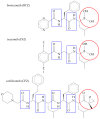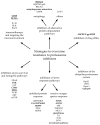Different Strategies to Overcome Resistance to Proteasome Inhibitors-A Summary 20 Years after Their Introduction
- PMID: 39201634
- PMCID: PMC11354503
- DOI: 10.3390/ijms25168949
Different Strategies to Overcome Resistance to Proteasome Inhibitors-A Summary 20 Years after Their Introduction
Abstract
Proteasome inhibitors (PIs), bortezomib, carfilzomib, and ixazomib, are the first-line treatment for multiple myeloma (MM). They inhibit cytosolic protein degradation in cells, which leads to the accumulation of misfolded and malfunctioned proteins in the cytosol and endoplasmic reticulum, resulting in cell death. Despite being a breakthrough in MM therapy, malignant cells develop resistance to PIs via different mechanisms. Understanding these mechanisms drives research toward new anticancer agents to overcome PI resistance. In this review, we summarize the mechanism of action of PIs and how MM cells adapt to these drugs to develop resistance. Finally, we explore these mechanisms to present strategies to interfere with PI resistance. The strategies include new inhibitors of the ubiquitin-proteasome system, drug efflux inhibitors, autophagy disruption, targeting stress response mechanisms, affecting survival and cell cycle regulators, bone marrow microenvironment modulation, and immunotherapy. We list potential pharmacological targets examined in in vitro, in vivo, and clinical studies. Some of these strategies have already provided clinicians with new anti-MM medications, such as panobinostat and selinexor. We hope that further exploration of the subject will broaden the range of therapeutic options and improve patient outcomes.
Keywords: molecular medicine; proteasome inhibitors; treatment resistance.
Conflict of interest statement
The authors declare no conflicts of interest.
Figures




Similar articles
-
Inhibition of the ʟ-glutamine transporter ASCT2 sensitizes plasma cell myeloma cells to proteasome inhibitors.Cancer Lett. 2021 Jun 1;507:13-25. doi: 10.1016/j.canlet.2021.02.020. Epub 2021 Mar 10. Cancer Lett. 2021. PMID: 33713737
-
Targeting the ubiquitin-proteasome pathway to overcome anti-cancer drug resistance.Drug Resist Updat. 2020 Jan;48:100663. doi: 10.1016/j.drup.2019.100663. Epub 2019 Nov 11. Drug Resist Updat. 2020. PMID: 31785545 Review.
-
Novel cell line models to study mechanisms and overcoming strategies of proteasome inhibitor resistance in multiple myeloma.Biochim Biophys Acta Mol Basis Dis. 2019 Jun 1;1865(6):1666-1676. doi: 10.1016/j.bbadis.2019.04.003. Epub 2019 Apr 4. Biochim Biophys Acta Mol Basis Dis. 2019. PMID: 30954557
-
Research progress in proteasome inhibitor resistance to multiple myeloma.Zhong Nan Da Xue Xue Bao Yi Xue Ban. 2021 Aug 28;46(8):900-908. doi: 10.11817/j.issn.1672-7347.2021.200430. Zhong Nan Da Xue Xue Bao Yi Xue Ban. 2021. PMID: 34565737 Free PMC article. Chinese, English.
-
Safety of proteasome inhibitors for treatment of multiple myeloma.Expert Opin Drug Saf. 2017 Feb;16(2):167-183. doi: 10.1080/14740338.2017.1259310. Epub 2016 Nov 28. Expert Opin Drug Saf. 2017. PMID: 27841029 Review.
Cited by
-
Targeting Active Microglia Alleviates Distal Edge of Proton Radiation-induced Neural Damage.Adv Radiat Oncol. 2025 Mar 18;10(5):101764. doi: 10.1016/j.adro.2025.101764. eCollection 2025 May. Adv Radiat Oncol. 2025. PMID: 40291513 Free PMC article.
-
Prognostic Value of PSMB5 and Correlations with LC3II and Reactive Oxygen Species Levels in the Bone Marrow Mononuclear Cells of Bortezomib-Resistant Multiple Myeloma Patients.Curr Issues Mol Biol. 2025 Jan 6;47(1):32. doi: 10.3390/cimb47010032. Curr Issues Mol Biol. 2025. PMID: 39852147 Free PMC article.
-
REGγ-mediated Barrier Disruption and NF-κB Activation Aggravates Intestinal Inflammation in Necrotizing Enterocolitis.Inflammation. 2025 Aug;48(4):2476-2493. doi: 10.1007/s10753-024-02203-2. Epub 2024 Dec 10. Inflammation. 2025. PMID: 39653983
References
Publication types
MeSH terms
Substances
LinkOut - more resources
Full Text Sources
Medical
Research Materials
Miscellaneous

